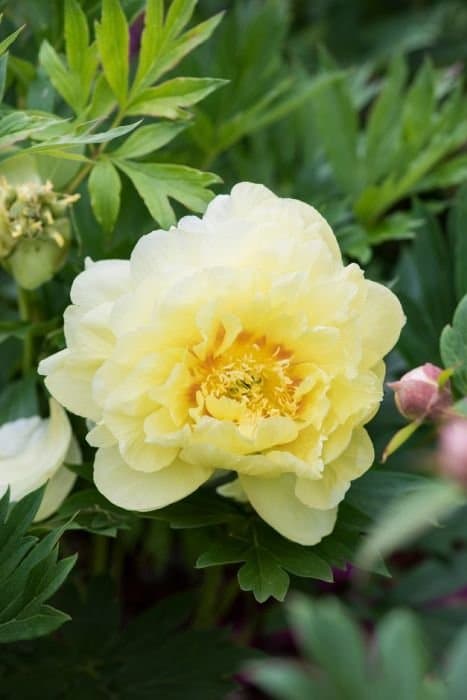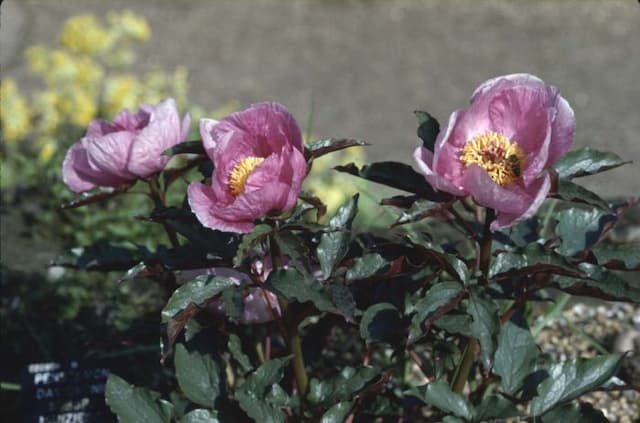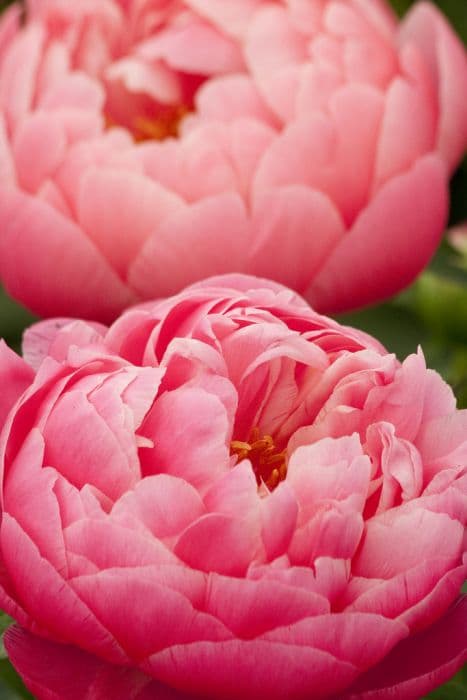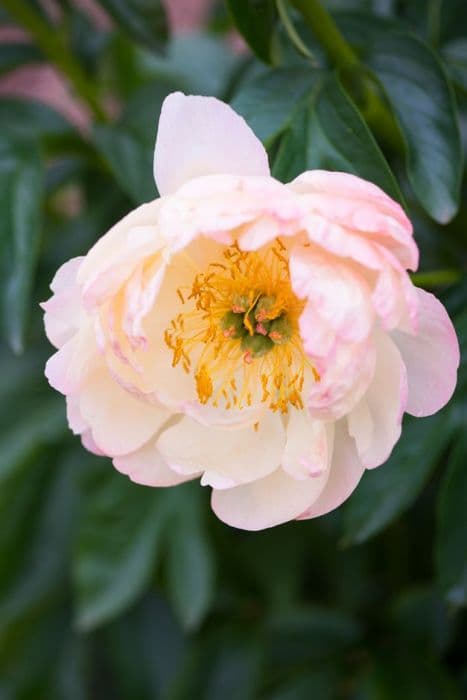Peony Paeonia lactiflora 'Monsieur Martin Cahuzac'

ABOUT
The plant known as peony 'Monsieur Martin Cahuzac' is a flowering variety with a lush and opulent appearance. This peony's blooms are a prime feature, characterized by a rich, deep pink hue that commands attention. The petals are often large and full, displaying a rounded shape with a softly ruffled texture that adds a sense of depth and complexity to the flower. In the center of these striking blooms, a cluster of yellow stamens creates an appealing contrast, drawing the eye and enhancing the overall visual impact of the flower. These stamens may also attract pollinators, adding ecological value to the plant's aesthetic appeal. The foliage of the peony 'Monsieur Martin Cahuzac' is a deep green color, providing a lush backdrop for the spectacular blooms. The leaves are typically broad and divided into several leaflets, which may have a slightly glossy surface that catches the light. This glossy sheen can make the green color appear even more vibrant, particularly when juxtaposed against the rich pinks of the petals. Overall, the peony 'Monsieur Martin Cahuzac' presents itself as a showy and elegant plant. Its pronounced blooms and contrasting foliage combine to make it a standout in any garden setting, where it can serve as a focal point or complement other plantings with its bold yet refined charm.
About this plant
 Names
NamesFamily
Paeoniaceae
Synonyms
Chinese Peony, Common Garden Peony
Common names
Paeonia lactiflora 'Monsieur Martin Cahuzac'.
 Toxicity
ToxicityTo humans
Peony, specifically the Paeonia lactiflora species, is considered to be non-toxic to humans. There should be no significant risk of poisoning from ingesting parts of this plant. However, it's always advisable to avoid consuming any plant parts if you're not certain of their safety, as individual reactions can vary and some people might experience mild gastrointestinal upset or be allergic to certain plant compounds.
To pets
Peony, namely Paeonia lactiflora, is generally regarded as mildly toxic to pets, including cats and dogs. If pets ingest parts of the plant, they might exhibit symptoms such as vomiting or diarrhea. While peonies are not typically known for being severely toxic to pets, it is still best to prevent your pets from eating the plant to avoid any potential discomfort or adverse reactions.
 Characteristics
CharacteristicsLife cycle
Perennials
Foliage type
Deciduous
Color of leaves
Green
Flower color
Pink
Height
2-3 feet [60-90 cm]
Spread
2-3 feet [60-90 cm]
Plant type
Herb
Hardiness zones
3-8
Native area
Asia
Benefits
 General Benefits
General Benefits- Aesthetic Appeal: 'Monsieur Martin Cahuzac', commonly known as peony, offers large, fragrant blooms that provide visual and olfactory pleasure in spring and early summer gardens.
- Landscape Versatility: Peonies can be used in a variety of garden settings, including borders, as focal points, or in mass planting for a dramatic effect.
- Longevity: Peonies are perennials with a long lifespan, often living for decades and providing consistent blooms each year with minimal care.
- Seasonal Interest: Peonies offer seasonal interest with their lush foliage after flowering, which can provide a backdrop for other plants in a garden composition.
- Hardiness: Peonies are hardy and resilient, able to withstand cold winters in many climate zones.
- Low Maintenance: Once established, peonies require little maintenance, making them suitable for gardeners seeking low-effort plants.
- Pollinator Attraction: The flowers of the peony attract bees and other pollinators, contributing to the health of the local ecosystem.
- Cut Flowers: The blooms of peonies are excellent for cutting and arranging in floral displays, lasting well in a vase.
- Propagatable: Peonies can be propagated by division, making them easy to share with fellow gardeners or to spread throughout your own garden space.
- Deer Resistance: Peonies are generally deer-resistant, reducing garden damage in areas with high deer populations.
 Medical Properties
Medical Properties- Anti-inflammatory: The root of Paeonia lactiflora, commonly known as white peony, has been used in traditional Chinese medicine to reduce inflammation.
- Analgesic: Components of white peony may have pain-relieving properties.
- Immunomodulatory: White peony might have effects on the immune system, potentially regulating immune responses.
- Antispasmodic: Traditional uses of white peony include alleviating muscle cramps and spasms.
- Hepatoprotective: There is some evidence suggesting that Paeonia lactiflora may offer protection to the liver.
- Antioxidant: The root of white peony contains compounds that may have antioxidant properties, helping to protect cells from damage caused by free radicals.
- Neuroprotective: White peony might have properties that protect the nervous system.
- Cardiovascular health: It may have beneficial effects on blood circulation and overall cardiovascular health, according to traditional use.
 Air-purifying Qualities
Air-purifying QualitiesThis plant is not specifically known for air purifying qualities.
 Other Uses
Other Uses- Paeonia lactiflora, commonly known as the Chinese peony, has been used historically in fashion, with its motifs appearing in luxurious textiles and embroideries, especially in East Asia.
- The Chinese peony's petals have been used in perfumery to provide a delicate, floral scent and are sometimes incorporated in high-end fragrances.
- In decorative arts, the Chinese peony pattern has been a popular design in ceramic and porcelain works, often symbolizing wealth and honor.
- The plant can be used as a natural dye, where the petals provide soft pink to purple hues for fabrics and artisanal crafts.
- As edible flowers, peony petals can be crystallized in sugar and used as elegant cake decorations or garnishes for desserts and cocktails.
- In the culinary arts, Chinese peony petals have been infused into syrups to flavor beverages or meals with a subtle floral note.
- In gardening, the plant is often used for companion planting to support biodiversity and attract pollinators like bees and butterflies to the garden.
- Chinese peony blooms are used in feng shui practices to help create balance and bring good fortune to home gardens or interior spaces.
- During special events, such as weddings, the luxurious appearance of the Chinese peony is sought after for floral arrangements and bouquets to signify prosperity and romance.
- The robust root system of the Chinese peony can help with soil stabilization in landscapes and prevent erosion in vulnerable garden areas.
Interesting Facts
 Feng Shui
Feng ShuiPeony is often used in Feng Shui for its symbol of beauty, romance, and prosperity, often recommended to enhance love and marriage luck. It should be placed in the southwest corner of a garden or home to attract positive relationship energy.
 Zodiac Sign Compitability
Zodiac Sign CompitabilityPeony is not used in astrology practice.
 Plant Symbolism
Plant Symbolism- Prosperity: The lush, full blooms of the peony are often associated with wealth and good fortune, making them popular in celebrations and ceremonies related to success and prosperity.
- Romance: Peonies are also symbolic of romance and romantic love, often used in weddings and given as tokens of affection due to their voluptuous and soft petals.
- Compassion: Some cultures associate the gentle appearance of the peony with compassion, tenderness, and nurturing qualities.
- Honor: In certain traditions, peonies symbolize honor and high esteem, often presented in recognition of someone's achievements or status.
- Beauty: The striking beauty of the peony makes it a symbol of physical and aesthetic beauty, celebrating the visual pleasures of nature.
- Happy Marriage: Because of the peony's associations with romantic love and prosperity, it has come to symbolize a happy, flourishing marriage.
- Good Luck: Labeling the peony as a harbinger of good luck, it's often used in cultural practices to encourage positive outcomes and to ward off negative energies.
 Water
WaterPeonies, including the Paeonia lactiflora 'Monsieur Martin Cahuzac', require consistent moisture, especially during the growing season. They should be watered deeply once a week, receiving approximately 1 inch of water each time. This equates to around 0.6 gallons per square foot, ensuring the soil is moist but not waterlogged. During hot or dry spells, water twice a week. Cut back on watering as the plant goes dormant in fall.
 Light
LightPeonies, like Paeonia lactiflora 'Monsieur Martin Cahuzac', thrive in full sunlight with at least 6 hours of direct sunlight daily. They can handle partial shade, but flowering is often best in full sun. Place them in a spot that isn't shaded by large trees or buildings for optimal light exposure.
 Temperature
TemperaturePeonies, such as Paeonia lactiflora 'Monsieur Martin Cahuzac', perform best in temperate regions with cold winters. They can survive winter temperatures as low as -20°F and summer temperatures up to 90°F. The ideal temperature for vigorous growth ranges from 65°F to 75°F during the growing season.
 Pruning
PruningPeonies, including Paeonia lactiflora 'Monsieur Martin Cahuzac', should be pruned to remove spent flowers after blooming, which encourages healthy growth and prevents seed development that can reduce next year's blooms. In late fall, after the foliage has died back, cut the stems down to about 3 inches above the ground to help prevent overwintering diseases. Prune annually to maintain plant health.
 Cleaning
CleaningAs needed
 Soil
SoilPeonies prefer well-drained, loamy soil with a pH of 6.5 to 7.0. A mix of two parts garden soil, one part compost, and a handful of granular organic fertilizer is suitable for optimal growth and blooming.
 Repotting
RepottingPeonies, including 'Monsieur Martin Cahuzac', generally do not need frequent repotting and can thrive for many years without being disturbed. It is recommended to repot only if the plant outgrows its space or every 10-15 years.
 Humidity & Misting
Humidity & MistingPeonies like 'Monsieur Martin Cahuzac' are fairly adaptable but prefer average humidity levels. They do not require high humidity and are quite tolerant of the humidity levels typically found outdoors in their growing zones.
 Suitable locations
Suitable locationsIndoor
Ensure bright light, cool temp, regular watering for indoor peony.
Outdoor
Plant in sun, enrich soil, water deeply, mulch in winter.
Hardiness zone
3-8 USDA
 Life cycle
Life cyclePaeonia lactiflora 'Monsieur Martin Cahuzac', commonly known as the Chinese peony, typically begins its life cycle as a dormant tuberous root planted in autumn. In early spring, red shoots emerge from the soil, developing into large, green, divided leaves as temperatures increase. By late spring to early summer, large, fragrant flowers bloom in shades of pink, red, or white, which are highly attractive to pollinators. After flowering, seed pods may form, which eventually dry and release seeds in late summer or fall; however, cultivation is more commonly done through root division. Throughout the summer, the vigorous foliage continues to photosynthesize and store energy in the tuberous roots before the plant goes dormant in the fall, with leaves yellowing and dying back after the first frost. The cycle then repeats the following spring, with the plant gradually expanding in size each year.
 Propogation
PropogationPropogation time
Early fall
The most popular method of propagating the Paeonia lactiflora 'Monsieur Martin Cahuzac', commonly known as peony, is through division. This is typically done in the fall after the plant becomes dormant. To divide a peony clump, you should carefully dig around the plant to lift the root ball out of the ground with as little damage as possible. The roots should be washed or brushed free of soil, and any dead or decaying material should be removed. Using a sharp knife, the root mass is cut into sections, making sure each section has at least three to five eyes, which are the potential growth points for new shoots. These divisions can be replanted in well-draining soil at a depth where the eyes are 1 to 2 inches (2.5 to 5 cm) below the soil surface, ensuring proper development for the following season. Peonies require patience, as divided plants may take a few years to return to their full blooming potential.









